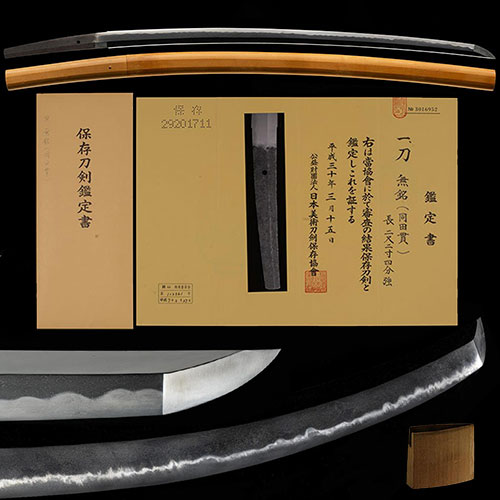
同田貫 刀 Doutanuki Katana
No.522255同田貫 正国 天正頃 加藤清正お抱え工 刃中の働き豊かな名品 二尺二寸四分Doutanuki Masakuni Around the Tensho period Kato Kiyomasa's personal wordsmith variety of works in sword a masterpiece 68.0cm
ご成約Sold
- 極めKiwame
- 同田貫Doutanuki
- 登録証Registration
- 岡山県 Okayama
- 時代Period
- 安土桃山AduchiMomoyama
- 法量Size
-
刃長 68.0cm (二尺二寸四分) 反り 1.6cm
元幅 3.0cm 先幅 2.1cm 元重 0.66cm 鎬厚 0.78cm 先重 0.50cm 鋒長 4.1cm 茎長 18.4cm 重量 705gHachou 68.0cm (二尺二寸四分) Sori 1.6cm
Moto-Haba 3.0cm Saki-Haba 2.1cm Moto-Kasane 0.66cm Shinogi-Thikess 0.78cm Saki-Kasane 0.50cm Kissaki-Chou 4.1cm Nakago-Chou 18.4cm Weight 705g - 国Country
- 肥後Higo
- 姿Shape
- 鎬造、庵棟、身幅広く、反り尋常、先反りつき、中鋒延びる。Shinogidukuri, Iorimune, Wide Mihaba, Standard Sori, Sakizori-tsuki, Chu-Kissaki extended
- 鍛Kitae
- 板目肌に、杢目交じり、棟寄り柾がかり、小沸微塵に付き、映りたつ。Itamehada, Mixed Mokume, MuneyoriMasagakari, Small-Nie entered finely, Utsuritatsu.
- 刃文Hamon
- 互の目に、小互の目交じり、湯走り・飛び焼き頻りにかかり、足・葉よく入り、小沸つき、金筋・砂流しかかり、匂口締り沈みごころ。Gunome, Mixed Small-Gunome, Yubashiri, Tobiyaki-shikirini-kakari, There are many Ashi and You, Small-Nie entered , Kinsuji and Sunagashi-kakari, Nioikuchi-shimari-shizumigokoro.
- 帽子Boushi
- 乱れ込んで小丸。Midarekonde-Komaru
- 茎Nakago
- 大磨上、先浅い栗尻、鑢目切、目釘孔一。Oh-suriage, Shallow Kurijiri, Yasurimegiri, Mekugiana is one(1)
- ハバキHabaki
- 木Wood
- 説明Drscription
- 同田貫派は肥後国延寿の末流と伝え、肥後菊池の地で天正十四年に領主となった加藤清正に見い出され、お抱工となっている。一派の刀工には上野介、兵部、左馬介、正国などがいる。加藤清正は、旗下の武将はもとより足軽の御貸刀も同田貫で揃え、熊本城にはこれら同田貫が装備されてたといい、それらは無銘がほとんどで、入っていても番号だけであったという。加藤家改易後、新たに入城した細川家は、豊後鍛冶を重用した為に同田貫派は一時衰退するが、新々刀期まで繁栄し、実用刀ながら、その切れ味をもって人気を博した。この刀は、沈みごころの互の目乱れを焼き、如何にも切れそうな一口で、乱れ映りがたつ地鉄に、湯走り・飛び焼き頻りにかかり、互の目に、足・葉よく入り、小沸よく付き、金筋・砂流し掛かるなど刃中の働き豊かな一口である。The Doutanuki school is said to be a descendant of the Enju clan in Higo Province, and was discovered and patronized by Kiyomasa Kato, who became the feudal lord in the 14th year of the Tensho era in the area of Higo Kikuchi.
Swordsmiths of this school include Kouzunosuke, Hyōbu, Samanosuke, and Masakuni. It is said that Kiyomasa Kato used Doutanuki to lend swords not only to his military commanders but also to his foot soldiers, and it is said that Kumamoto Castle was equipped with these Doutanuki, but most of them were unsigned, and even if they were included, they only had numbers.
After the Kato clan reformed, the Hosokawa family, which newly entered the castle, put heavy use of Bungo blacksmithing, and the Doutanuki school declined for a while, but it flourished until the Shinshintou era, and although it was a practical sword, it gained popularity for its sharpness.
This sword has Shizumigokoro-Gunome-midare-yaki, with a sword that seems to cut in any way, Jigane with Midare-Utsuri-tatsu, Yubashiri, Tobiyaki-shikirini-kakari, Gunome, There are many Ashi and You, Small-Nie-tsuki, Kinsuji and Sunagashi-kakaru It works well in sword.


